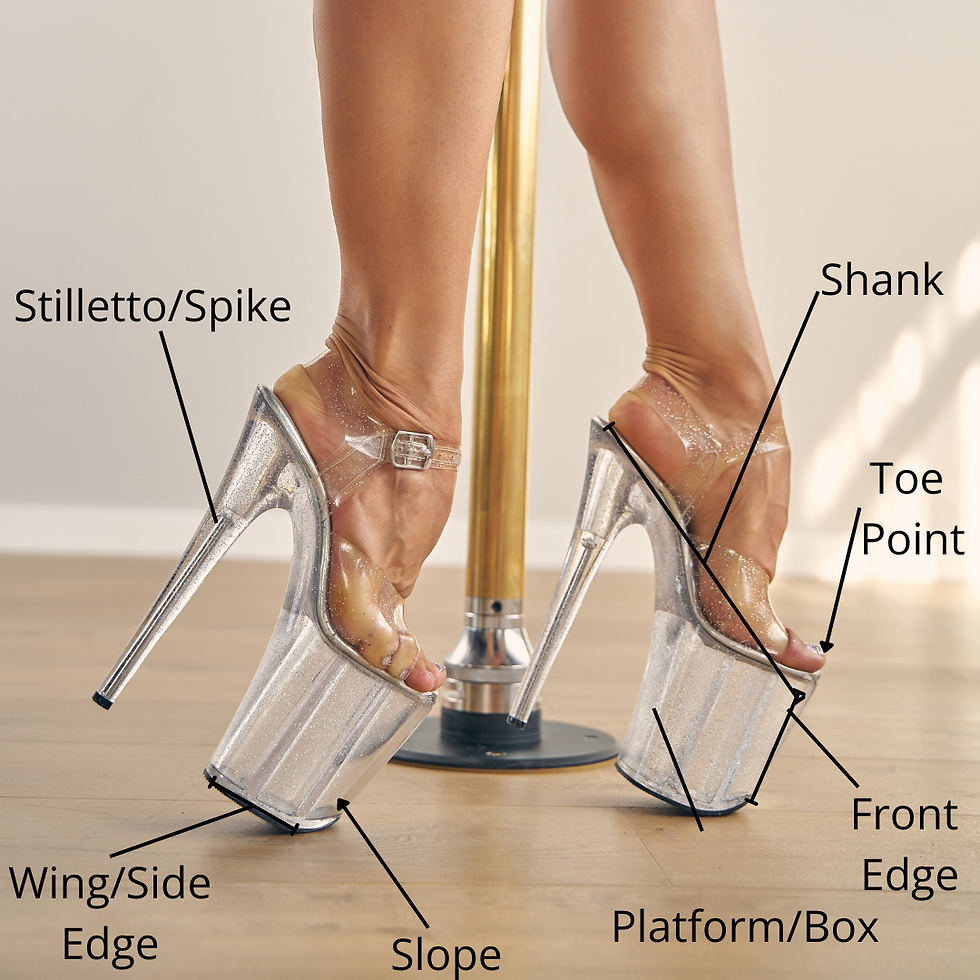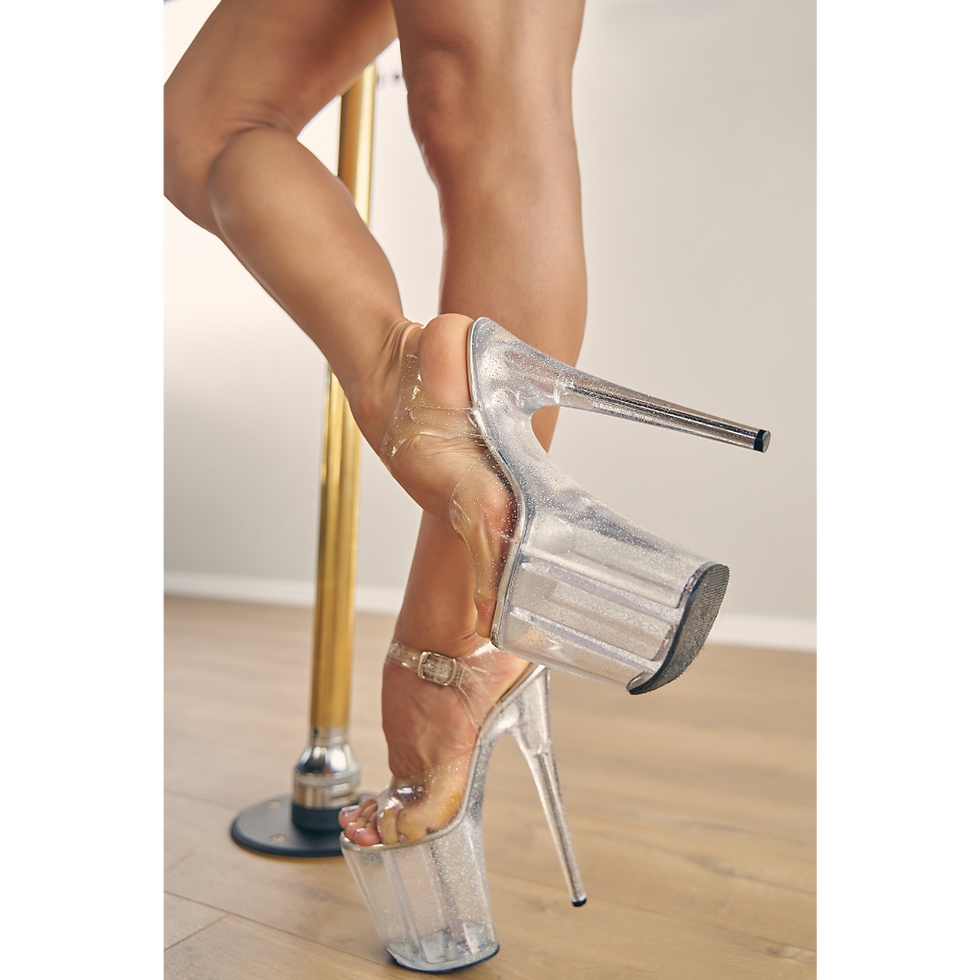Hypnotic Heels
- Danielle Davey
- Oct 14, 2023
- 7 min read
Theme of the day is heels love 😍. If you’ve ever worn a pair of pole platforms, you’ll know they take practice to dance, or even stand in! Some people make dancing in heels look as easy as breathing and as smooth as butter. For the rest of us, let’s take a deep dive on the gorgeous platform stiletto.
History
A blog on heels would be incomplete without acknowledging strippers, who paved the way for recreational polers period, but also to use platform heels. Platform shoes have featured in many cultures throughout history, with recurring themes of being elevated: in social status, stature, or aesthetically. The platform stiletto as we know it comes from strip clubs and sex workers, who wear these shoes to catch attention, give them an ethereal and graceful vibe, and to accentuate the curves of the body.
Fast forward
As pole dance came to studios from strip cubs, so did the shoes! We now recognise them as an apparatus all of their own, with many uses and advantages, including:
Helping create a mood or character
Accentuating leg lines
Toe protection for floorwork (eg kips)
Create slide for floorwork
Provide extra grip on the pole
Expands opportunities to move in different ways, eg for pointe and edgework
Boots may also provide additional ankle support, skin protection and grip points
Anatomy of a shoe
Let’s learn some terminology about our shoes! These features have some cool functions when we dance, so getting to know your shoe can really help your heels work.

What about different types of shoes?
The design of pole heels is quite ingenious! As they were created to be worn for long shifts on one’s feet in a club, they are remarkably comfortable for such tall heels. Different types have some different uses or advantages:
Heel height - 6 and 7 inch heels often popular with beginners. Keep in mind the slope of the shank (angle you have to stand at) is often higher in a 6 inch heel, so it may not be easier! While balance is easier being lower to the ground, more advanced heel wearers tend to upgrade to 8 inch heels as there is far more space on the platform to slide in floor work, and for edge and pointe work.
Sandals vs boots- sandals require more ankle stability and better balance, where boots provide a little ankle support. Can be helpful for beginners, those prone to rolling ankles, or for flips. With more stability comes reduced mobility, so sandals are often better for edgework and artistic ankle movements.
Open vs closed toe- open toe provides more breathability to help with sweat and hygiene, and may fit some foot shapes better. Closed toe provides more protection for floor work.
Materials- some materials may provide better grip to the pole (i.e plastic vs faux fur, suede, etc).
What is pointe and edgework?

Pointe work is a name borrowed from classical ballet. Ballet dancers wear specialised slippers to allow them to rise up to stand on the block of the shoe so the ankle and toes are both fully pointed. This takes an incredible amount of strength, skill, and practice. In a pole heel, we transfer weight toward the front slope of the shoe, pointing the ankle. The toes press down to help stabilise within the shoe, but because of the shape of the shank, they don’t fully point. There are many similarities and differences, which we will dive into another day! For now, this is what each looks like. Many heels dancers dance ‘en pointe’ on their heel to create a different quality to their dancing and also enabling them to slide and pivot on the floor in different ways.

Edgework utilises the wings/edges of the platform and the spike or stiletto of the shoe. In edgework, the ankle may be used in any number of positions and directions of movement, not just the standard plantarflexion/pointing of the foot. Again, it creates a different aesthetic and opens more options for how a dancer can move. Of course, this means it requires learning a whole new skill set as the foot and ankle are used in a whole new way!
Anatomy
We can’t go any further without a quick look at anatomy of the foot and ankle. In fact, we need to look at the whole lower leg, since many of the muscles that control the foot and ankle are actually in the shin/calf area.
There are 33 joints in the foot and ankle, made up by 26 bones. There are also about 33 (depending on your anatomy) muscle attachments on the foot! So, there is an insane potential for different movements there, with loads of potential supports and controls to tap into, if you know how.
Movements
Alt Text: Images shows actions of the foot and ankle, including eversion, inversion, plantar flexion, dorsiflexion, supination, pronation, toe extension, toe flexion.
Here are some of the more important actions to know of. They are all complex movements that require a huge team effort from many joints and muscles.
Main Muscle Groups
Here is a *very* simplified run down on the anatomy and function of a super complex area.

Plantar flexors:
Points the ankle
Help stabilise the ankle (prevent rolling, help balance)
Allows for rapid absorption and production of force

Lateral Compartment/Peroneals:
Evert/wing the ankle
Help stabilise the ankle (prevent rolling, help balance)
Medial compartment:

Inverts the ankle
Contributes to plantar flexion
Supports the midfoot
Assists with balance and control

Dorsiflexors:
Flex the foot
Extend the toes
Contribues to stability and control
We use EVERY single one of these muscle groups just to walk in our heels (or out of them, for that matter). Is it any wonder we are often pulling our heels off and rubbing our poor, sore feet by the end of a class?
For example, to stand in heels we need plantar flexion range of motion, intrinsics and the deep posterior compartment to stabilise the foot, ankle and arch, the lateral compartment to balance that by stabilising the outside of the ankle. And this is a real over simplification!
If we add walking to the mix, there is also an element of controlled dorsiflexion and plantar flexion of the ankle, so we add more active work from the anterior compartment to flex the foot so it can clear the floor and we can land heel first, and the calf complex to point the foot to roll to the front of the shoe and push off to take a step.
Mind spiralling yet? You’ll be pleased to know we’ll be covering pointe and edge-work in more depth another day then 😊
Real Talk (from a physio)
Now seems like a good time to sit you down and have a chat about taking care of our feet. It’s easy to see that feet are really amazing, complex pieces of machinery, and heels work is really quite hard. Unfortunately, our feet often are forgotten and we just expect them to do the work with no conditioning. Would you expect to get your invert or do a handspring without some conditioning to prepare? Absolutely not!
Sadly, this forgetfulness stems from beyond the pole community. Feet have been poorly understood and treated by many health professionals for years. They are often given passive treatments such as rigid orthotics, massage, and injections as the only methods of treatment for aches, pains, and poor function. Yes, the foot is complex and requires above average knowledge to assess, but there is no reason that we shouldn’t be treating our feet like any other area of the body...
...and do targeted prehab and rehab exercise!!
Conditioning time!
It’s the part you’ve been waiting for. If you experience calf cramping, sore feet, struggle with balance or rolling ankles, or just lack the strength and coordination to use your heels, this could be a place to start.
As usual, these are intended as educational only, and are not treatment for anyone’s specific situation. If you are in pain or have had an injury, please book with us online to be assessed so we can create a tailored plan with you.
Out of Heels
You’ve heard us talk about “off the pole” conditioning. How about “out of heels” conditioning? You don’t need to be wearing your heels to be working on strength and technique for them. Try these!
In the Heels
Of course, we have some “in the heels” conditioning to help you get used to working within your heels effectively as well.
Post Heels Ouch!
While we love heels, they really aren’t optimal foot wear to allow good foot function. They are rigid, squash the toes into an unnatural shape, and they don’t allow for normal mechanics of the foot. If your foot is healthy, strong, and mobile, it can often manage these non-ideal conditions for a bit. To help them continue to cope, it’s nice to give them a little love to restore their normal mobility after a workout in heels. Here are some nice ideas
Conditioning tips
Oof! It was SO hard to choose our favourite exercises. There are so many that can be useful. If you’re feeling overwhelmed trying to narrow down what conditioning YOUR feet need, think about these tips:
Look at the function you want to improve and the anatomy involved- if you roll your ankles, you might want to focus on balance and strengthening the outside of the ankle
Make sure you’re working hard enough - loading calf with theraband isn’t near the load of standing on pointe
Healthy feet outside of heels will cope better with being in heels- think about how you treat your feet day to day
Put your conditioning in your warmup (or come in for class 5min early)
Use your cool down time wisely- add some recovery/mobility/coordination, rather than just stretching your calves
Injured or wanting to improve your heel work?
If you’re experiencing a foot or ankle injury, or are wanting to work on your heel work,
our online team are always here to help. We understand pole dancer's feet like very few others. Online telehealth appointments can be booked via our ‘Book Online’ page that can be found here. Assessment and tailored rehabilitation are provided in accordance with best practice and evidence-based treatment to help you unleash your 'pole-tential'.
Until next time, train safe & happy heel-wearing.
The Pole Physio
x
Author and member of The Pole Physio online team, Dani, has been a lover and wearer of pole heels for many years. She also does ballet and has done classical ballet pointe work. Dani has a special interest in foot and ankle issues, having done several additional courses to learn from leaders in foot and ankle treatment, from renowned dance physios to amazing running podiatrists. She has treated hundreds of polers and ballet dancers with foot and ankle issues, as well as teaching heels conditioning and flow classes for some years. If you’re in need of an upgrade for your rehab or prehab, you can book with Dani online here.
















https://www.yplocal.com/usa/new-york/business-professional-services/dahlcore-security-guard-services
savvy mining…
crypto mining…
cesur mining…
six mining…
stainless steel…
万事达U卡办理 万事达U卡办理
VISA银联U卡办理 VISA银联U卡办理
U卡办理 U卡办理
Stainless Steel…
蜘蛛池搭建 蜘蛛池搭建
savvy mining…
crypto mining…
cesur mining…
six mining…
stainless steel…
万事达U卡办理 万事达U卡办理
VISA银联U卡办理 VISA银联U卡办理
U卡办理 U卡办理
Stainless Steel…
蜘蛛池搭建 蜘蛛池搭建
savvy mining…
crypto mining…
cesur mining…
six mining…
stainless steel…
万事达U卡办理 万事达U卡办理
VISA银联U卡办理 VISA银联U卡办理
U卡办理 U卡办理
Stainless Steel…
蜘蛛池搭建 蜘蛛池搭建
savvy mining…
crypto mining…
cesur mining…
six mining…
stainless steel…
万事达U卡办理 万事达U卡办理
VISA银联U卡办理 VISA银联U卡办理
U卡办理 U卡办理
Stainless Steel…
蜘蛛池搭建 蜘蛛池搭建